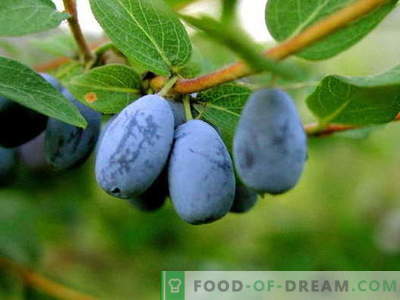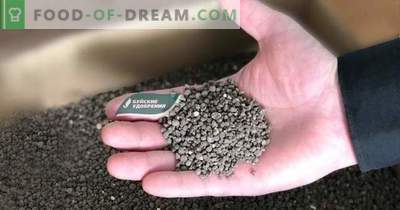The poetic image of an old folk tale about a sleeping beauty arose from observations of a wild rose - rosehip. The tale of the sleeping beauty of some nations is called “The Wild Rosette”. Rosehip shoots wilted tops, forming arcs. From the buds appear new shoots, curving and also arcuate. A lot of shoots that grow from the roots, intertwined with curved old. Formation of impassable thickets covered with sharp curved spines. Therefore, young branches of wild rose, its flowers and tasty fruits are inaccessible to mice or other animals. Some birds eat ripe fruits. Like a sleeping beauty, the flower is dozing under the protection of branches with sharp thorns and blooms magnificently under the rays of the spring sun.
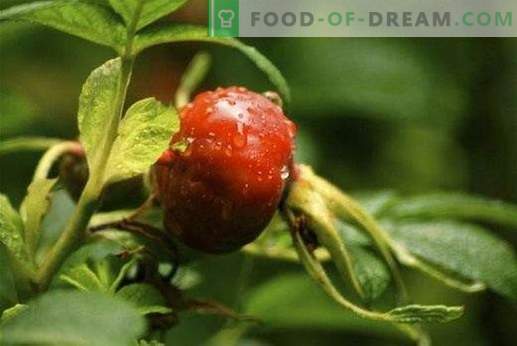
© Vasya Artyomov
Rosehip (Latin Rósa) is a genus of wild plants of the Pink family. It has many cultural forms, bred under the name Rose.
Deciduous shrub is usually 1-5 meters high. Sometimes there are low tree forms.
Shoots covered with spines.
Leaves are pinnate, with paired stipules (rarely, simple and without stipules), contain 5-7 leaflets.
The flowers are usually pale pink, 4-6 cm in diameter. There are forms with flowers that show signs of terry.
The fruit is false (hypanthium), oval or ovate-spherical, when ripe red, orange, purple-red color, with numerous nuts inside. Coloring hypanthia due to the high content of carotene. The fruits ripen in October.

© El Bichólogo Errante (Busy again!)
Properties
Hips have been used in folk medicine since ancient times for gingival bleeding. From the hips also prepared a decoction to recuperate. From the deciduous and root parts of the hips prepared healing tinctures. Rosehip syrup with honey drank in inflammatory diseases and ulceration in the mouth.
Therapeutic Uses
According to most scientists, wild rose has choleretic, anti-inflammatory, diuretic, tonic, healing, anti-sclerotic properties, improves metabolism. Tincture and rosehip juice are very useful for depleting the body, as well as for various infections, with gastritis with low acidity, atherosclerosis, hypertension, cholecystitis. The drugs are used in the form of tinctures, extracts, syrups, are part of the vitamin complexes. The drugs are used as a multivitamin remedy for vitamin deficiency, and for diseases accompanied by an increased need for vitamins. From the hips, in addition, get the essential oil, which is rich in vitamin “E”.

© j_silla
Benefits
Fruits of ribs, ripening in late summer - early autumn, are a real storehouse of vitamins and other substances necessary for the human body. Among them, first of all, vitamin C, the average content of which in the hips is about 6%. Some species of this plant generally contain up to 18% ascorbic acid! Lemons, known as one of the most popular sources of vitamin C, can not even be compared with the hips, because they contain fifty times less of this vitamin than the hips. Can you imagine how useful rosehip is?
But wild rose berries are not only rich in vitamin C, they include in their biological composition vitamins A, K, P, E, as well as vitamins of group B. No less diverse is the complex of microelements, which is contained in the hips: potassium and calcium, iron and magnesium, manganese and sodium, phosphorus and chromium, as well as copper, cobalt, molybdenum and manganese. But that's not all! In the dog rose there are sugars, pectins, tannins, organic acids, essential oil and many other substances necessary for the normal functioning of the human body. The rich biological composition of wild rose defines a wide scope of application of this medicinal plant for the treatment of various diseases. It is known that dog rose has a beneficial effect on the work of the digestive organs, stimulates more active kidney activity, has a diuretic effect. The use of rose hips prevents the development of inflammatory processes, and also contributes to the destruction of harmful bacteria.
Dried dogrose roots have astringent abilities, and seeds are a source of oil, which includes a whole complex of vitamins and fatty acids. It is used to speed up the process of wound healing and as an anti-inflammatory agent.
The high content of ascorbic acid makes it possible to use wild rose in case of beriberi, atherosclerosis, colds and use it to strengthen the immune system. And due to the presence in its composition of vitamins P and K, wild rose has such rare useful properties as the acceleration of regeneration processes and bone healing. The use of rose hips also allows you to effectively strengthen the vascular system, treat disorders of the genitourinary system, improve the condition of patients with malaria, anemia, bleeding, and help lower blood pressure.
To take advantage of the healing powers of this amazing plant, you can not only brew the traditional decoction of its fruits, but also prepare tea, tinctures, extracts, etc.
Strain the resulting composition, drink a glass before a meal, half the glass is enough for the children.

© me_suz
How to Brew Rosehips
To get the most out of the beneficial properties of wild rose, you need to be able to brew it properly. We will tell you how to make an infusion and decoction of rosehips. Important - the proportion of hips and water should be 1 to 10, that is, per liter of water 100 grams. rose hips, it's about 4 tablespoons. Infusion of rosehips is easy to prepare, but long enough - put the crushed fruits in a thermos, pour boiling water and leave for seven hours.
The broth will take even more useful substances from the rose hips - first boil the hips in a sealed container for one hour, pouring in water, if necessary, to the required proportions, then insist 12 hours.
Some More Recipes
“Honey from the color of wild rose is made up as: take fresh honey as you like and boil it, and collect the foam so that the honey is clean and strain it through a handkerchief, cut it into the honey and add color Cook a little, and now he is ready. Honey with rose hips is strong and, taken internally, strengthens the body and blood, destroys harmful sputum, which arise from melancholia, and also destroys those harmful properties that appear from excessive sputum. The juice from rosehip color, taken inside, relieves the headache, but it is also useful for the eyes ”.
From the hips, they prepare a healing tea. - one tablespoon of dried fruits should be poured with a glass of boiling water, left for 10 minutes and drunk, adding sugar to taste.
Vitamin infusion of wild rose - three tablespoons of dried fruit pour two cups of boiling water, and insist for several hours. Drink half a glass several times a day. To improve the taste, you can add sugar.
Rose hip - 8 tablespoons of dry fruits pour 4 cups boiling water, add 4 tablespoons of sugar and boil for 10 minutes. Insist 4 hours, strain and bottle.
Rose hip jam - 100 g of fresh rosehip petals should be filled with sugar syrup prepared at the rate of 700 g sugar per 1 liter of water, add 1 g of citric acid, bring to a boil and immediately pour into clean hot jars. You can roast the seeds of wild rose, grind on a coffee grinder and make a healthy drink with a pleasant aroma that can replace your coffee.
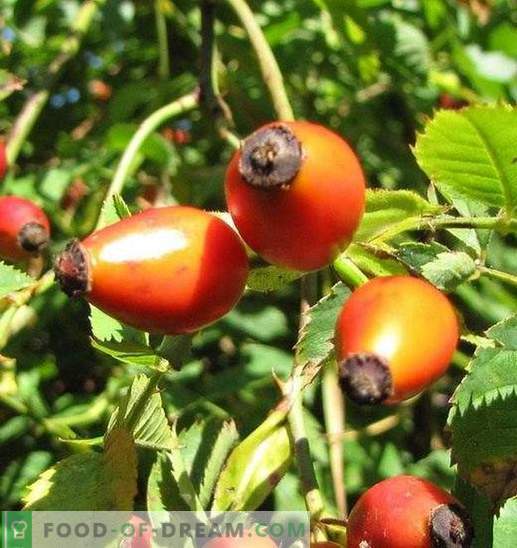
© Phil Sellens
Views
All wild roses and rosehips (Rosa) bear bright red, orange or brown berries. Representing a charming sight in the autumn and winter from the point of view of garden design, not all types of roses, however, are equal in quality of fruits. The most valuable in terms of the content of useful substances are the berries of the following types of wild rose:
Rosehip wrinkled (Rosa rugosa) is a widespread plant that has long been successfully naturalized throughout Europe and America. Fruits of rose rugoza are rich in vitamin C and sugars, are easy to process, and, as admitted by dog rose lovers, have the best taste, a bit reminiscent of cranberries. The shrub grows strongly, giving a lot of root sprout, and is quite decorative in the garden with its beautiful foliage yellowing in autumn, fragrant pink or white (Alba form) flowers (there are also terry varieties), as well as bright large red-orange fruits.
Cinnamon rosehip, or May rosehip (Rosa cinnamomea, or Rosa majalis),, as well as its varieties, are considered the most valuable in terms of vitamin C content and medicinal properties. The plant is common in central Russia, as well as in northern and central Europe. Fruits are large, round, red.
Rosehip dog (Rosa canina) - has the most valuable medicinal fruits. The berries are very large, round or oval.
Hybrid Musk Roses Hybrids of Rose () - decorative dog roses with dense semi-shiny foliage and burgundy young shoots. The berries are red. Recommended varieties: Buff Beauty, Felicia and Penelope. Rosa Moyesii, originating from China. Fruits are large, bright red. Recommended variety: Geranium with bright red flowers and berries.
Rosa woodsii (wild rose zagorny), Rosa gymnocarpa (wild rose hips), Rosa californica (California rose hips), Rosa spithamea and others - wild roses originating from North America.
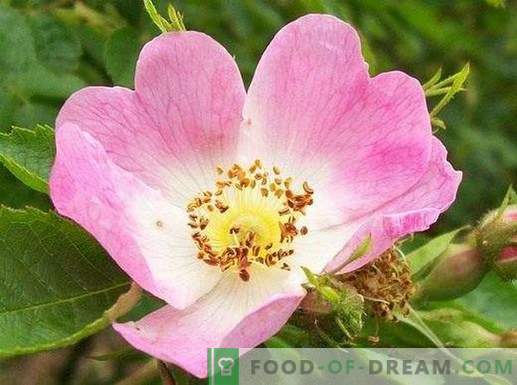
© anemoneprojectors









